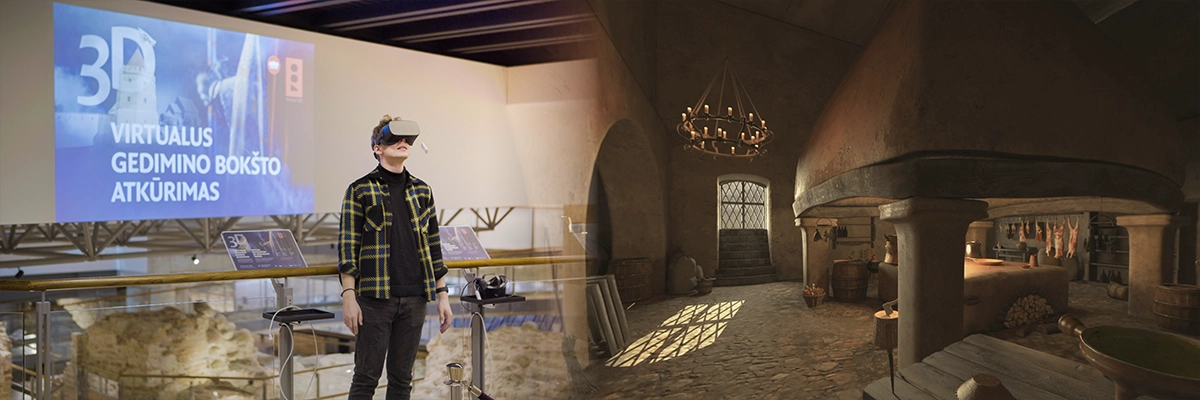
Virtual reality (VR) is an increasingly popular technology. You can find it in various settings, including museums. While VR can offer some unique and immersive experiences, there are also some potential drawbacks. In this blog post, we’ll explore the pros and cons of using VR in a museum setting, and offer some guidance on when VR may or may not be appropriate.
What is VR and how it’s used?
Virtual Reality (VR) is a computer-generated simulation of an environment that allows users to interact with it realistically. It’s videly popular in the gaming industry, entertainment sector, education or training, and typically uses a headset tethered to a computer or standalone (without the need of computer). Technology advances crazy fast, so now even big and complicated VR experiences are using standalone VR headsets, which are portable and much more convenient to use as well. There are many different ways to use VR in Museums and experience centers, but some of the most common uses include:
Entertainment: Even though gaming is one of the most popular uses for VR, it has found its way into entertainment as well, like showing unique places and processes, recreation, three-dimensional drawing, etc.
Education: VR is used for educational purposes, such as simulations or depictions of historical settings too. But if your goal is to teach some specific processes, VR for training can be a unique and powerful way of doing so.
Pros and cons
There are pros and cons to incorporating VR into museums. Despite the fact that it can provide an immersive and realistic experience that can bring history to life, there are concerns about the long duration of the VR experience and whether it is appropriate for all audiences. Another thing to consider is whether the user understands controls. You have to keep in mind that the user will need some guidance and support in learning how to use VR.
There are many potential benefits of using VR in museums. VR can help to engage visitors who might otherwise be uninterested in traditional exhibits or provide accessibility for visitors with disabilities or those who are unable to travel to the museum in person. Additionally, VR can be a powerful educational tool, providing an immersive and realistic experience that helps bring history to life.
However, there are also some drawbacks to using VR in museums. One concern is – the duration of the experience. Will the user have enough time to watch it? How will this duration affect the overall flow of visitors to the museum? If a museum has big groups of visitors, having only one VR headset might disrupt the flow. Another concern is that not all audiences will appreciate or understand a virtual reality experience. Additionally, some people may find VR experiences overwhelming or too complicated.
Ultimately, whether or not to incorporate VR into a museum will depend on particular needs and resources.
When to use it in museums
There are several situations when it might be appropriate to use VR in a museum setting. For example, VR could be used to give visitors a virtual tour of a historic site that no longer exists or to allow them to experience an exhibit in a way that would not be possible in person. Additionally, it can engage audiences who might otherwise be uninterested in traditional museum exhibits. For instance, children and young adults are often more engaged by interactive experiences, making VR a good option for museums that want to appeal to these demographics.
Some museums have already started to experiment with VR. The British Museum, for example, has created a VR experience called The Last Supper. It allows visitors to step inside Leonardo da Vincis’ painting of the same name. Other museums are using VR to transport visitors back in time, such as the National Museum of African American History and Culture in Washington DC, which has a VR experience called Reconstruction: The Second Civil War. Valdovų rūmai museum is a pioneer in Lithuania with their first VR experience successfully immersing people since 2017. After great success and positive feedback, they recently presented another VR experience – demonstrating historical changes of the palace and castle in Vilnius. Valdovų rūmai is not the only museum in Lithuania using VR to involve the audience. Pasvalio krašto museum, Alytaus kraštotyros museum, Tado Ivanausko zoo museum, and many other museums use 360 videos and VR headsets to create a WOW effect and get more attention from the audience.
All things considered, VR can be a powerful educational tool, providing visitors with an immersive and memorable experience that can help them learn about and understand complex topics in a fun and easy way.
